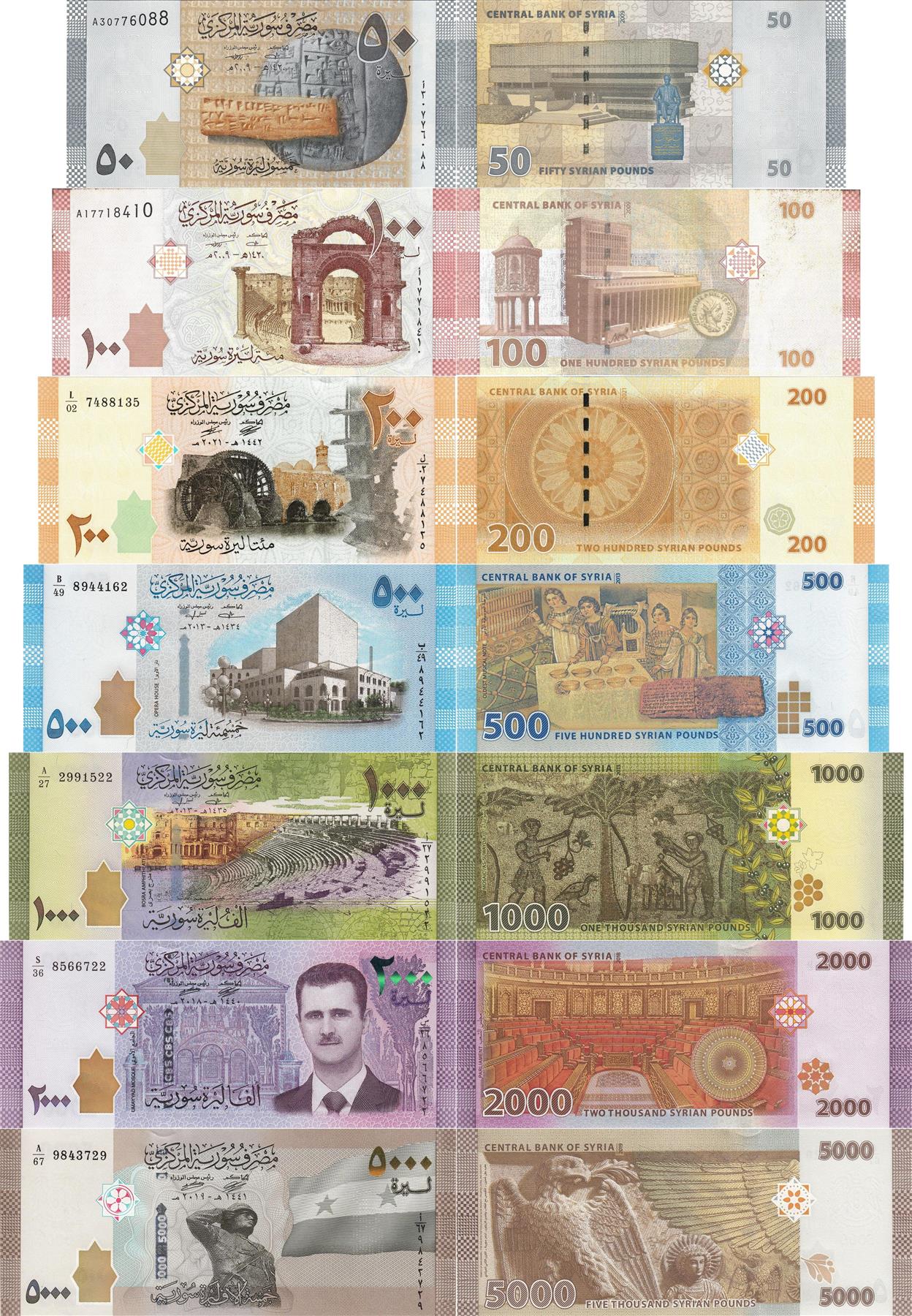Number of banknotes: 7
Condition: Uncirculated
Denomination: 50 Pounds, 200 Pounds, 500 Pounds, 1000 Pounds, 2000 Pounds, 5000 Pounds
Value: 50 Pounds 50SYP = USD 0.020, 100 Pounds 100SYP = USD 0.040, 200 Pounds 200SYP = USD 0.08, 500 Pounds 500SYP = USD 0.20, 1000 Pounds 1000SYP = USD 0.40, 2000 Pounds 2000SYP = USD 0.80, 5000 Pounds 5000SYP = USD 1.99
Currency: Pound
Currency rate: 50 Pounds 50SYP = USD 0.020, 100 Pounds 100SYP = USD 0.040, 200 Pounds 200SYP = USD 0.08, 500 Pounds 500SYP = USD 0.20, 1000 Pounds 1000SYP = USD 0.40, 2000 Pounds 2000SYP = USD 0.80, 5000 Pounds 5000SYP = USD 1.99
Type: Standard banknote
Condition: Uncirculated
Year: 2009 - 2023
Numismatic period: Arab Republic 1961-date
Composition: Paper (Cotton Paper), Paper
Weight: 1 g.
Shape: Rectangular
Issuing bank: Central Bank of Syria (مصرف سورية المركزي)
Size: 135 × 65mm, 140 × 65mm, 145 × 65mm, 150 × 65mm, 155 × 65mm, 158 × 65mm
Watermark: Arabian horse head and Electrotype 50, Head of Arabian horse; Electrotype 100, Horse head and denomination., Coat of Arms,  © gyoschak (CC BY-NC-SA) , Coat of Arms and electrotype denomination 2000, Coat of arms of the Syrian Arab Republic and electrotype "5000".
© gyoschak (CC BY-NC-SA) , Coat of Arms and electrotype denomination 2000, Coat of arms of the Syrian Arab Republic and electrotype "5000".
Watermark text: Arabian horse head and Electrotype 50, Head of Arabian horse; Electrotype 100, Horse head and denomination., Coat of Arms, © gyoschak (CC BY-NC-SA), Coat of Arms and electrotype denomination 2000, Coat of arms of the Syrian Arab Republic and electrotype "5000".
Obverse: Ugarit alphabet on ancient cuneiform clay tablets from Ebla, Bab el-Hawa (Gate of the Wind), the Western Gate, built from black basalt stone, situated at the western end of the Decumanus Maximus, Bosra's main thoroughfare. The Bosra Amphitheatre., In tha middle- The Norias of Hama (Arabic: نواعير حماةu200e) are a number of Norias ("wheels of pots") along the Orontes River in the city of Hama, Syria. Only seventeen of the original Norias remain. They are mostly unused now and serve an aesthetic purpose. They were called "The most splendid Norias ever constructed". The Norias of Hama were submitted as a tentative World Heritage Site by the Syrian Arab Republic in June 1999.At right- The Nur Al-Din Mosque (Arabic: جامع نور الدينu200e) orJami Nur al-Din is a Zengid-era mosque in Hama, Syria. It was founded by Nur al-Din in 1163-64 CE. It also contained a historic Minbar from the same date, which is now held at the local Hama Museum.The mosque was profoundly damaged in the 1982 shelling of the city and subsequently restored to its current state., Opera house at right., Bosra amphitheater, Dark purple print on multishade light purple and blue underprint; black serial number in both eastern Arabic and western numerals.In the middle - The Umayyad Mosque (Arabic: الْجَامِع الْأُمَوِيu200e), also known as the Great Mosque of Damascus (Arabic: جَامِع بَنِي أُمَيَّة الْكَبِير), located in the old city of Damascus, is one of the largest and oldest mosques in the world. The mosque is also important in Islam because of its historical and eschatological reports and events associated with the mosque.At right - Bashar Hafez al-Assa (born 11 September 1965) is a Syrian politician who has been the 19th president of Syria since 17 July 2000. In addition, he is the commander-in-chief of the Syrian Armed Forces and regional secretary of the Arab Socialist Ba'ath Party's branch in Syria., Syrian soldier saluting next to the Flag of Syria.
Obverse lettering: A30776088مصرف سورية المركزيخمسون ليرة سورية ٥٠, البنك المركزي في سوريا۱۰۰ مائة ليباس السوري, Central Bank of SyriaFive Hundred Syrian Pounds500, مصرف سورية المركزيلاكم رئيسمجلس الوزراء ١٤٤٠ هـ - ٢٠١٨ مUMAYYAD MOSQUE الجامع الأمويألف ليرة سوريةليرة, ٥٠٠٠
Obverse translation: Central Bank of Syria100 One Hundred Syrian Pounds, Central Bank of SyriaGovernorPrime Minister1440 AH - 2018 ADUmayyad MosqueOne Thousand Syrian PoundsLira, Central Bank of SyriaFive Thousand Pounds.
Obverse designer: Robert Kalina
Obverse scripts Arabic, Cuneiform, Latin, Arabic, Arabic, Latin
Reverse: Al-Asad National Library in Damascus and statue of Hafez al-Ásad, The dome of the Treasury of Damascus in the Umayyad Mosque. Central Bank of Syria on the Sabaa Bahrat Square (Square of the Seven Fountains) in Damascus. Ancient Silver Antoninianus coin of Roman Emperor Philip the Arab, MarcusJulius Philippus Augustus, Philip I, or Philippus Arabs (Reign: 244-249)., Decorated Ceiling of the southern niche, at the Temple of Bel at the ancient Palmyra. The decoration of this ceiling was purely ornamental; in 1753 its design became known in Europe through engravings based on drawings by Giovanni Battista Borra.The Temple of Bel (Arabic: معبد بلu200e), sometimes also referred to as the "Temple of Baal", was an ancient temple located in Palmyra, Syria., Painting of artists and musicians., Mosaic of grape harvest in Roman ruins of As-Suwayda, olive branches, Dark brown print on multishade purple and light blue underprint.Torwards the left, the picture of the People's Council of Syria in Damascus., Fresco from the Baalshamin Temple and roman amphitheater in the ancient city of Palmyra.
Reverse lettering: CENTRAL BANK OF SYRIAPARLIAMENT مجلس الشعبTWO THOUSAND SYRIAN POUNDS, CENTRAL BANK OF SYRIA 5000TEMPLE OF BAALSHAMIN — THE SUN WITH THE EAGLE AND AN OLIVE BRANCH — PALMYRA, SYRIA 2ND CENTURYمعبد بلشامين - الشمس مع النسر وفرع الزيتون - بالميرا ، سوريا القرن الثاني5000 FIVE THOUSAND SYRIAN POUNDS 5000
Reverse translation: CENTRAL BANK OF SYRIA50 FIFTY SYRIAN POUNDS, Temple of Baalshamin - the sun with the eagle and an olive branch - Palmyra, Syria 2nd century
Reverse scripts Latin, Arabic, Latin
ℹ Themes: Mustache, Sculpture, Tower, Photoluminescence, Religious building, Coat of Arms, Flag, Building, Latent image, Coin depiction, War, Hologram, Micro inscriptions, Government building, Politician, Literature


